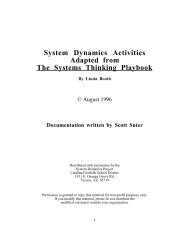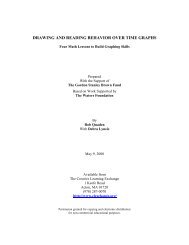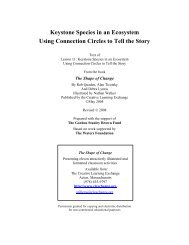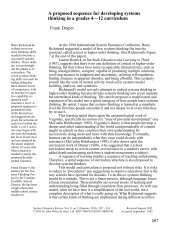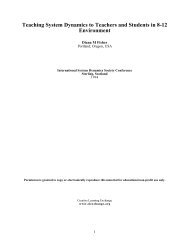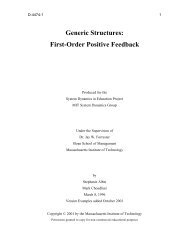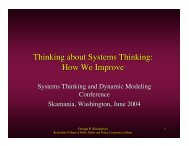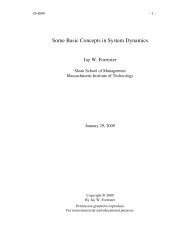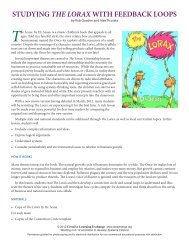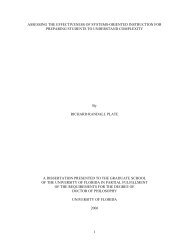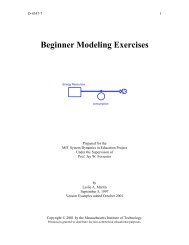118 System Dynamics Review Volume 9 Number 2 Summer 1993Fig. 4.Overpopulationfeedback loop<strong>and</strong> (4) <strong>the</strong> way in which each factor works to cause <strong>the</strong> effect is leftimplicit (represented only by <strong>the</strong> sign of <strong>the</strong> coefficients, i.e., this factorhas a positive or a negative influence).The systems <strong>thinking</strong> paradigm offers alternatives to each of <strong>the</strong>seassumptions. First, according to this paradigm, each of <strong>the</strong> causes islinked in a circular process to both <strong>the</strong> effect <strong>and</strong> to each of <strong>the</strong> o<strong>the</strong>rcauses. <strong>Systems</strong> thinkers refer to such circular processes as feedbackloops. Figure 4 illustrates two such loops. The shift from one-way tocircular causality, <strong>and</strong> from independent factors to interdependentrelations, is a profound one. In effect, it is a shift from viewing <strong>the</strong> worldas a set of static, stimulus-response relations to viewing it as an ongoing,interdependent, self-sustaining, dynamic process. It will also causestudents to think in a very different way about what is going on in <strong>the</strong>world around <strong>the</strong>m.The third assumption implicit in <strong>the</strong> laundry list paradigm is thatfactors have a static weighting. By contrast, in <strong>the</strong> systems <strong>thinking</strong> view,as Figure 4 suggests, <strong>the</strong> strength of <strong>the</strong> closed-loop relations is assumedto wax <strong>and</strong> wane over time. Some loops will dominate at first, o<strong>the</strong>r loopswill <strong>the</strong>n take over, <strong>and</strong> so on. There<strong>for</strong>e, addressing a problem is notseen as a one-shot deal. Ra<strong>the</strong>r, it is considered necessary to think in termsof ongoing, interdependent relations whose strengths vary over time,partly in response to interventions that may have been implemented into<strong>the</strong> system.The final assumption associated with laundry list <strong>thinking</strong> is thatcorrelation is good enough <strong>for</strong> explaining how a system works. Thesystems <strong>thinking</strong> paradigm challenges this regression analysis approach,offering in its place operational models of how things work. Thus, <strong>for</strong>someone steeped in <strong>the</strong> systems <strong>thinking</strong> paradigm, it would not beenough to identify <strong>the</strong> factors that are correlated with overpopulation.Instead, it would be necessary to actually offer an operational explanationof how overpopulation is generated. The contrast between <strong>the</strong> correlational<strong>and</strong> operational models of <strong>the</strong> overpopulation process is illustrated inFigures 5 <strong>and</strong> 6.The systems <strong>thinking</strong> paradigm, when combined with <strong>the</strong>learner-directed learning process, will breed students who are hungry tounderst<strong>and</strong> how things really work <strong>and</strong> who will continually be looking<strong>for</strong> how <strong>the</strong>se workings might
Richmond: <strong>Systems</strong> Thinking 119Fig. 5. AcorrelationalmodelFig. 6. Anoperationalmodelchange over time as a consequence of shifts in <strong>the</strong> relative strengths of <strong>the</strong>underlying dynamic relations.Thread 3: learning toolsTo fully meld a learner-directed learning process with <strong>the</strong> systems <strong>thinking</strong>paradigm, it is essential to have <strong>the</strong> right set of learning tools available <strong>for</strong>classroom <strong>and</strong> out-of-classroom use. The tools of a teacher-directed,laundry list learning process—textbooks <strong>and</strong> blackboards—will play asmaller role in a nontransmit, active learning process. Textbooks operate,in effect, as purveyors of silent lectures. Students read <strong>the</strong>m, <strong>for</strong> <strong>the</strong> mostpart, <strong>for</strong> <strong>the</strong> same reason <strong>the</strong>y currently go to class—to assimilate content.On blackboards teachers can chart static relations <strong>and</strong> display lists.However, blackboards are not well suited to analyzing a system'sdynamics. To support an inquiry-oriented, learner-directed learningprocess, textbooks <strong>and</strong> blackboards must share <strong>the</strong> stage with an emergingtool: <strong>the</strong> personal computer. The personal computer, with its rapidlyexp<strong>and</strong>ing sound <strong>and</strong> graphic animation capabilities, holds <strong>the</strong>



